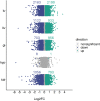The multi-tissue gene expression and physiological responses of water deprived Peromyscus eremicus
- PMID: 39118009
- PMCID: PMC11308687
- DOI: 10.1186/s12864-024-10629-z
The multi-tissue gene expression and physiological responses of water deprived Peromyscus eremicus
Abstract
The harsh and dry conditions of desert environments have resulted in genomic adaptations, allowing for desert organisms to withstand prolonged drought, extreme temperatures, and limited food resources. Here, we present a comprehensive exploration of gene expression across five tissues (kidney, liver, lung, gastrointestinal tract, and hypothalamus) and 19 phenotypic measurements to explore the whole-organism physiological and genomic response to water deprivation in the desert-adapted cactus mouse (Peromyscus eremicus). The findings encompass the identification of differentially expressed genes and correlative analysis between phenotypes and gene expression patterns across multiple tissues. Specifically, we found robust activation of the vasopressin renin-angiotensin-aldosterone system (RAAS) pathways, whose primary function is to manage water and solute balance. Animals reduced food intake during water deprivation, and upregulation of PCK1 highlights the adaptive response to reduced oral intake via its actions aimed at maintained serum glucose levels. Even with such responses to maintain water balance, hemoconcentration still occurred, prompting a protective downregulation of genes responsible for the production of clotting factors while simultaneously enhancing angiogenesis which is thought to maintain tissue perfusion. In this study, we elucidate the complex mechanisms involved in water balance in the desert-adapted cactus mouse, P. eremicus. By prioritizing a comprehensive analysis of whole-organism physiology and multi-tissue gene expression in a simulated desert environment, we describe the complex response of regulatory processes.
Keywords: Dehydration; Multi-tissue; Peromyscus; Physiology; RNAseq.
© 2024. The Author(s).
Conflict of interest statement
The authors declare no competing interests.
Figures



Update of
-
When the tap runs dry: The multi-tissue gene expression and physiological responses of water deprived Peromyscus eremicus.bioRxiv [Preprint]. 2024 Jan 25:2024.01.22.576658. doi: 10.1101/2024.01.22.576658. bioRxiv. 2024. Update in: BMC Genomics. 2024 Aug 8;25(1):770. doi: 10.1186/s12864-024-10629-z. PMID: 38328088 Free PMC article. Updated. Preprint.
Similar articles
-
Impacts of dietary fat on multi tissue gene expression in the desert-adapted cactus mouse.J Exp Biol. 2024 Dec 15;227(24):jeb247978. doi: 10.1242/jeb.247978. Epub 2024 Dec 16. J Exp Biol. 2024. PMID: 39676723 Free PMC article.
-
When the tap runs dry: The multi-tissue gene expression and physiological responses of water deprived Peromyscus eremicus.bioRxiv [Preprint]. 2024 Jan 25:2024.01.22.576658. doi: 10.1101/2024.01.22.576658. bioRxiv. 2024. Update in: BMC Genomics. 2024 Aug 8;25(1):770. doi: 10.1186/s12864-024-10629-z. PMID: 38328088 Free PMC article. Updated. Preprint.
-
Characterizing the reproductive transcriptomic correlates of acute dehydration in males in the desert-adapted rodent, Peromyscus eremicus.BMC Genomics. 2017 Jun 23;18(1):473. doi: 10.1186/s12864-017-3840-1. BMC Genomics. 2017. PMID: 28645248 Free PMC article.
-
Peromyscus transcriptomics: Understanding adaptation and gene expression plasticity within and between species of deer mice.Semin Cell Dev Biol. 2017 Jan;61:131-139. doi: 10.1016/j.semcdb.2016.08.011. Epub 2016 Aug 12. Semin Cell Dev Biol. 2017. PMID: 27531052 Free PMC article. Review.
-
Life in Deserts: The Genetic Basis of Mammalian Desert Adaptation.Trends Ecol Evol. 2021 Jul;36(7):637-650. doi: 10.1016/j.tree.2021.03.007. Epub 2021 Apr 13. Trends Ecol Evol. 2021. PMID: 33863602 Free PMC article. Review.
Cited by
-
Impacts of dietary fat on multi tissue gene expression in the desert-adapted cactus mouse.J Exp Biol. 2024 Dec 15;227(24):jeb247978. doi: 10.1242/jeb.247978. Epub 2024 Dec 16. J Exp Biol. 2024. PMID: 39676723 Free PMC article.
References
MeSH terms
Grants and funding
LinkOut - more resources
Full Text Sources

